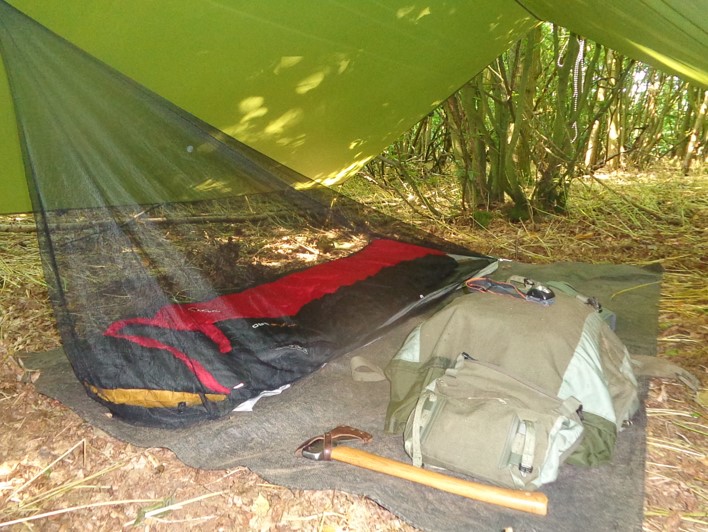I thought I’d put a few thoughts together on selecting a tarp to help with choosing the right one.

For me a big part of bushcraft is connecting with the natural world, it’s an exploration and appreciation of the marvels that mother nature provides. And for that reason when I’m sleeping in the woods I prefer to use a tarpaulin, it gives me a feeling of immediacy, of being a part of the woodland, it makes me feel connected to the land.
There’s nothing quite like lying under a tarp and watching the sun come up, in fact I also rather enjoy lying in bed and watching the rain fall all around me! Now I’m not saying that there’s anything wrong with sleeping in a tent, because there isn’t, but I find a tent puts an unnecessary barrier between me and the very things that I want to experience and enjoy. So in this article I want to talk about tarps, or more specifically, what to look out for when you’re buying a tarp.
In case you haven’t read them yet, here’s a post on putting up a tarp and another on taking it down again.
Features
There’re a lot of tarps on the market and selecting a tarp which is right for you can be a tricky task. Here’s a few things to bear in mind.
Size
How big a tarp do you want? This will be affected by factors such as how many people will be using it and what you’re using it for, so is the tarp just for you; is it for a few of you; is it for a communal area, is it for a cooking area?
Remember that the bigger the tarp clearly the more room you’ll have underneath, but it’s also likely to be proportionally heavier. Over the last few years I’ve noticed a trend towards bigger and bigger tarps and at least one issue I’ve seen is finding trees that are far enough apart to hang the tarp!
Shape
Which leads us into shape. Whilst there are some awesome 5 sided tarps out there, in general you’re looking at either square or rectangle shaped. Probably a personal choice, although I prefer a square tarp as it can then be used in a diamond shape as well, which can be useful if you’re using the tarp in conjunction with a hammock. With that said, plenty of people use a rectangular tarp over a hammock as, depending which way around you have it, you can get extra protection on the sides.
Fixing points
Here I’m referring to the number of tabs around the sides and along the ridge line of the tarp. In some regards it’s a case of the more the merrier as the more fixing points you have the more configurations are available to you.
I would definitely recommend staying away from tarps with an even number of fixing points. If there are, say, 4 fixing points along the side then there won’t be one in the middle; you need an odd number to have a centre fixing point, and a centre fixing point gives much more flexibility in terms of configurations.
Also check how the fixing points are attached to the tarp. Look for a good, solid attachment, maybe even re-enforced. This first photo shows the fixing point on my own tarp.

This next one shows the re-enforcing on a DD Tarp, you can see it’s very robust.

There are cheap tarps on the market for a fiver, but these invariably have round eyelets that pull out under even moderate tension, so whilst they have there place I wouldn’t want to rely on one in even breezy conditions.
Material
Often today tarps are synthetic, mostly nylon or polyester, and this generally means they’re fairly lightweight, but a lot of bushcrafters like their oilcloth or waxed canvas. Be aware that these old school tarps can be bulkier and heavier.
I’ve had my tarp (shown in this photo) for the best part of 15 years now; it’s a synthetic tarp, 2.8 x 2.8 metres and has 5 fixing points to a side and 3 down the ridgeline. For me this is a great size for a solo shelter, plenty of room for me and my kit but it will also comfortably get 2 people under; it accommodated me and a friend during a week long paddle along the Wye 12 years ago.

Colour
Maybe not at the top of your list when it comes to selecting a tarp, but colour choice is important. Generally in bushcraft people use a tarp that will blend in. In the spring, summer and early autumn green is probably best for blending in, but it can stand out in the winter.

Whereas a brown tarp is proabaly better in the winter but not so much the rest of the year.

Putting up tarps and hammocks is something we do on both our 2 Day Bushcraft Course and 5 Day Bushcraft Course. It really is a fantastic way to camp out in the woods, really helps with ‘leave no trace’, is quick to put up and comfortable to boot. You can see photos from those courses, as well as all of our others, on our Facebook page.

